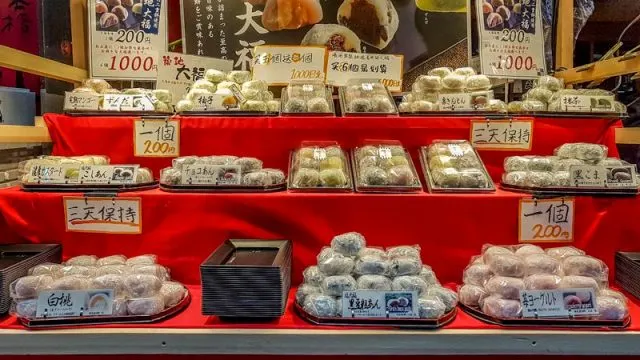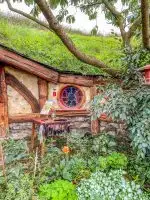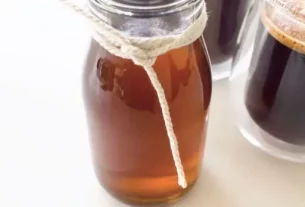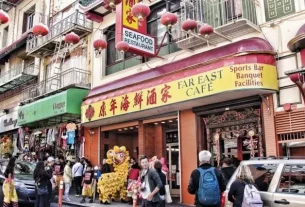Kuromon Market is a MUST for the visiting foodie in Osaka. Located in Namba, it’s operated in the same location for 120 years. There’s plenty of ready to eat options in addition fresh unique produce so why not come for a look around and a seafood breakfast or lunch?

I absolutely adore Japanese food so it’s no coincidence that foodie markets are high on our list of places to visit as we travel around Japan. Some of our favourites so far we’ve visited are Nishiki market in Kyoto, Omi-cho market in Kanazawa, Tsukiji in Tokyo and Hakodate market in Hokkaido. This wasn’t our first stay in Osaka but we’d somehow not made it to Kuromon market yet so staying at the Namba Oriental Hotel in the heart of Namba on this trip made the ideal base for a visit.
We were out the door early, possibly a bit over-excited anticipating the seafood breakfast to come and arrived at the market well ahead of the 9am opening time. I tend to forget that Japanese produce markets don’t open super early like they do in Australia.
Watching the market stall owners unpacking and setting out the trays of fresh seafood and not being able to order was way too tempting so we headed off for a walk down to the canal, past the iconic Glico man and back through the narrow alleys of Yokocho before settling on a drip coffee cafe near the market for a caffeine hit before getting started.
We walked through the market doors right on 9am, this is the best time to visit as it will quickly get super busy and you want the freshest and best selection of the day. Once the crowds built it gets tricky to move through and make your selection although it does enhance the hustle and bustle atmosphere.
Our first stop was at Marusho-Suisan one of the stallholders we’d watched setting up near the north-west entry gate and I had to come back for the unagi, one of my favourites but Drew hadn’t tried it before. Now we’re both fans.
Unagi is freshwater eel and it’s grilled over hot coals while being basted with a sweet soy sauce, it’s something you really want to be freshly cooked and it was. We also had a mornay crab here served from the shell. I was really torn wanting to keep going through their delicious looking selection until I was full but we agreed to continue on through the market while we had appetite left.
Marusho-Suisan is one of the stalls that has a few seats inside to sit and eat your food but many don’t. It’s not usual in Japan to walk and eat, generally it would be considered quite rude but there is some acceptance of foreigners standing and eating. A better option is to make your selection and take it along to the information centre where there are large tables and seating. This is more comfortable and has the benefit of meeting others doing the same, sharing information on where they’ve been and what they bought.
Crab is very popular in the market including giant crab legs cooked on the grill and served with big pliers for cracking open the shell. Although crab isn’t caught locally to Osaka, most of it coming from the cold waters of Hokkaido in northern Japan, it’s an incredibly popular dish with entire restaurants dedicated to it. It’s a delicacy and priced accordingly so having the opportunity to have a smaller taste in the market from the grill or in another dish such as sushi or sashimi bowls is a good option.
Something else you’ll see all across the market is sea urchin, called uni in Japanese. It’s another delicacy and a dish that you really want to taste the first time super fresh and well prepared. When it’s good it’s buttery, salty, smooth and really special, when it’s not so good it’s watery, the texture is weird and you won’t want to eat it a second time.

Seafood makes up around 25% of the markets 180 stalls. Meat, vegetables, snacks and sweets are also popular but with the increasing number of tourists visiting the market you will find everything from beauty products to clothes and kitchen implements if you walk all they way through the 600 metre main stretch of the market and the various offshoots. While the crowds within the market are largely the public, made up of both locals and tourists, over half the sales are wholesale made to Osaka restaurants and businesses.
Prawns (ebi), squid (ika) and a wide variety of fish are also popular throughout the market and about this point I was tempted into a small restaurant specialising in donburi. Chirashi zushi is an easy option for having a small taste of several different types of sashimi. While I’ve acquired a taste for raw prawns and most fish served this way I’m not a big fan of the squid. In Hakodate where I’ve had it before it was cut into fine ribbons but at Kuramon was served as a fairly large piece, it has a slick rubbery texture and is almost impossible to bite or chew and I have to admit for me that wasn’t something I’d include again by choice.
Other stalls stocked a wide variety of vegetables and mushrooms. While I didn’t have the ability to use them while in Japan and Australia has really strict biosecurity controls I do find the vegetables and pickles fascinating.
One store we stopped at was Iseya which was founded in 1897. They stock otsokemono, traditional Japanese pickles and have a good variety including some favourites such as daikon, the familiar Japanese radish in miso and narazuke which are vegetables preserved in a by-product of sake production. They also stock other staples of the Japanese home kitchen such as miso used in all manner of sauces and soups and umeboshi, the sour pickled plum that you might have found in the middle of an onigiri.
Something we could stock up on and use are the snacks. They are delicious so we stocked up on several packs of the spicy wasabi beans and various salty rice crackers in the local style.
Another shop to watch out for although they aren’t as locally handmade as they might appear are the mochi. You’ll see almost identical stores in other markets but the product is excellent. Real fresh mochi is super soft and delicate. It’s like a pillowy cloud around the centre filling.
Traditionally this filling was a sweetened red bean paste but now the mochi itself is sometimes lightly flavoured and modern centres include cherry blossom, lemon, yuzu, chestnut and many others. Perhaps best of all though are the ones topped with one bright red and juicy strawberry. These are heavenly. For those like me with a serious addiction to mochi you can buy 6 packs to take home but the fresh strawberry version is best eaten immediately.
History of Kuromon Market
Fish traders operated unofficially in the area occupied by Kuromon market since the 1820’s but it wasn’t until 1902 that it officially became a market.
It was named Kuromon Ichiba, kuro meaning black and mon, gate. You might be expecting to see a large black gate at the entrance as you arrive but there isn’t one. The name came from the distinctive black gates of the nearby Enmyoji temple but when the temple burned down about 10 years after the market opened, the name stuck.
Discover the market with a local guide
Another option to consider is joining a small group tour with a local guide to explore the market. Magical Trip runs a variety of tours in the Kansai region and we’re booked to join them on a couple of others during our next visit in May. Watch out for full review of those coming soon.
During the Kuromon Market tour you’ll spend a couple of hours with your guide tasting from the variety of food on offer at the market vendors stores. The Magical Trip guides are local, friendly and they speak excellent English so this is the ideal opportunity to ask all the questions you have about the market, Japanese foods and Osaka in general on a fun and relaxed tour.
<< Check available dates and book your Kuromon Market tour >>
Getting to Kuromon Ichiba Market
Address: 2 Chome-3-2 Nipponbashi, Chuo, Osaka, Osaka Prefecture 542-0073, Japan
If you are staying in Namba the markets are an easy walk from anywhere in that area. You can see it on the map below marked with a red pin together with other reference points mentioned in this article marked in blue.
If you are arriving by public transport make your way to Nippombashi station on the Sennichimae subway line. From the station take exit 10 and it’s literally a 1-2 minute walk just around the corner as you can see on the map above.
Visitor FAQ for Kuromon Market
When is Kuromon market open?
The market opens at 9 am and closes at 6 pm every day.
Is there an entry fee?
The market is open to the public and there’s no cost for visitors to wander through. A few places have samples but in general, you will be purchasing the snacks and meals you want to try. The variety and quality is excellent but unlike many markets across Asia, it’s not where you’d necessarily head for a budget meal.
Can I sit down to eat?
There are many small restaurants in and around the market that have counter seating for you to enjoy your meal. If you prefer to select from the takeaway options or the grills around the market you can make your way to the information centre and eat at the communal tables with other market visitors.
Are there more things to do in Namba?
Kuromon market is located in Namba, a part of Osaka known for its incredible food culture and a wide selection of restaurants. While in Namba you might also want to:
- Explore the Dotonbori canal area. Once known for its theatres it’s now a diverse restaurant and entertainment destination
- Eat Takoyaki, a real Osaka street food experience that featured in a Michelin guide. It’s delicious and this is the neighbourhood to try it.
- Have your photo taken in front of the iconic Glico running man neon sign
- Walk the narrow laneways of Hozen-ji yokocho and find the moss-covered temple guardian
- Shop up a storm and explore the relaxation spaces at Namba Parks
- Check out the latest electronics in Denden town
Do you enjoy visiting new foodie markets on your travels? Have you been to Kuromon Ichiba Market?













